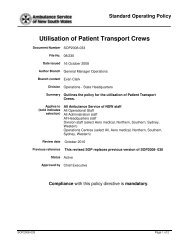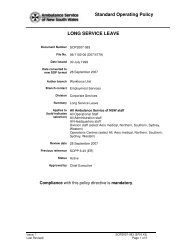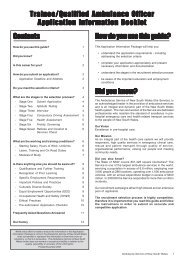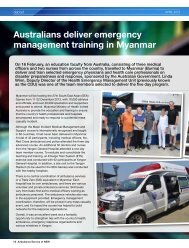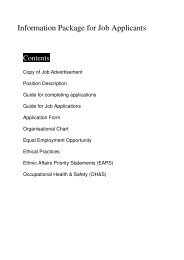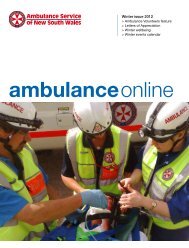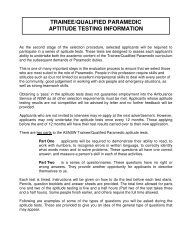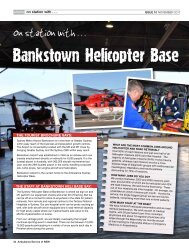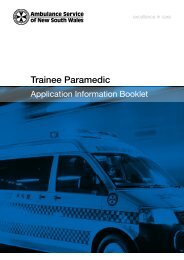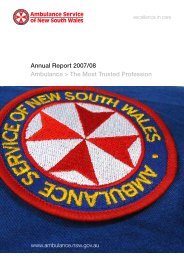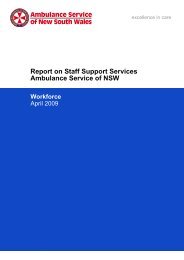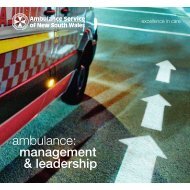atsb final report released 16 may 2013 - Ambulance Service of NSW
atsb final report released 16 may 2013 - Ambulance Service of NSW
atsb final report released 16 may 2013 - Ambulance Service of NSW
Create successful ePaper yourself
Turn your PDF publications into a flip-book with our unique Google optimized e-Paper software.
It was also considered unlikely that the rope or anchors had failed during the winch,as examination <strong>of</strong> the duty paramedic’s camming devices and the tag line, includingits associated weak link, did not identify any evidence <strong>of</strong> their failure.The only remaining possibilities were that either the paramedic elected not toestablish the stabilising system, or that he was in the process <strong>of</strong> establishing it whenhe and the patient were inadvertently pulled from the rock ledge.In respect <strong>of</strong> the possibility that the duty paramedic changed his mind and electednot to establish the stabilising system, ATSB investigators and SCAT paramedicswho accessed the rock ledge following the accident, assessed that the terrain <strong>may</strong>have permitted a helicopter to attain a near-vertical position for the winch. If theduty paramedic had formed a similar view from the winch point on the ledge, andconcluded that any pendulous tendency at winch pick-up would be minimal, he <strong>may</strong>have considered that a stabilising line was unnecessary. However, the lack <strong>of</strong>information about whether the duty paramedic changed the initial plan to use astabilising system, precluded any further assessment <strong>of</strong> this possibility.The injured canyoner’s recollection that, contrary to normal practice, the tag linebag was secured to the duty paramedic’s leg, the fact that the canyoner and dutyparamedic were tangled in the tag line when they came to rest on the rocks below,and the presence <strong>of</strong> the knots and karabiner on the tag line could support thehypothesis that a stabilising line was being established when the accident occurred.In contrast, the establishment <strong>of</strong> a stabilising system using the tag line would havebeen difficult for the duty paramedic once connected to the canyoner and equipmentvia the winch hook, as his mobility would have been limited.Given the low light conditions that existed at the time <strong>of</strong> the winch, it is possiblethat the ACM <strong>may</strong> have misinterpreted the duty paramedic’s movement inpreparing a stabilising rope as an indication that he was ready to be lifted.Although there was no evidence that a stabilising system was established prior tothe fall, the ATSB considered whether one would have affected the outcome. Thepurpose <strong>of</strong> the planned stabilising system was to control any pendulous tendency,rather than to support the full weight <strong>of</strong> the injured canyoner, paramedic andequipment once winched from the ledge. In this context, any device that was onlyintended to control pendulous movement, including its associated anchors, <strong>may</strong> nothave been strong enough to arrest the fall. In addition, the weak link that was foundattached to the tag line would have failed at a weight lower than the combinedweight on the rescue hook, meaning that any rope system that used that weak linkwould probably have failed as the canyoner, equipment and paramedic fell. TheATSB concluded that the establishment <strong>of</strong> a stabilising system using the availableequipment <strong>may</strong> not have affected the outcome.Use <strong>of</strong> the helicopter’s lightingThe ATSB considered the potential that the use <strong>of</strong> the available lighting influencedthe development <strong>of</strong> the accident. The winch-mounted lights were primarily intendedto illuminate the area vertically below the winch. Given the <strong>of</strong>fset position <strong>of</strong> thehelicopter, they would have been <strong>of</strong> limited use in illuminating the winch cableclearly, as required by the operator’s operations manual.The ACM did use the handheld searchlight during the winch. However, he also hadto control the winch via a pendant controller and manually control the winch cable,- 39 -



